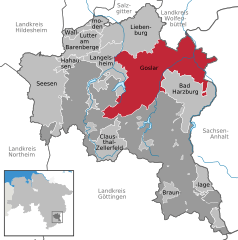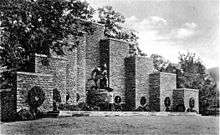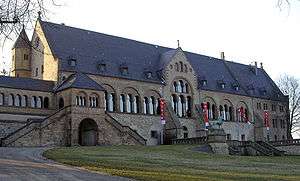Goslar
| Goslar | ||
|---|---|---|
 | ||
| ||
 Goslar | ||
Location of Goslar within Goslar district 
 | ||
| Coordinates: 51°54′26″N 10°25′48″E / 51.90722°N 10.43000°ECoordinates: 51°54′26″N 10°25′48″E / 51.90722°N 10.43000°E | ||
| Country | Germany | |
| State | Lower Saxony | |
| District | Goslar | |
| Government | ||
| • Lord Mayor | Dr Oliver Junk[1][2] (CDU) | |
| Area | ||
| • Total | 163.71 km2 (63.21 sq mi) | |
| Population (2015-12-31)[3] | ||
| • Total | 50,782 | |
| • Density | 310/km2 (800/sq mi) | |
| Time zone | CET/CEST (UTC+1/+2) | |
| Postal codes | 38640, 38642, 38644 | |
| Dialling codes | 05321, 05325 | |
| Vehicle registration | GS | |
| Website | www.goslar.de | |
| Mines of Rammelsberg, Historic Town of Goslar and Upper Harz Water Management System | |
|---|---|
| Name as inscribed on the World Heritage List | |
 | |
| Type | Cultural |
| Criteria | i, iv |
| Reference | 623 |
| UNESCO region | Europe and North America |
| Inscription history | |
| Inscription | 1992 (16th Session) |
Goslar is a historic town in Lower Saxony, Germany. It is the administrative centre of the district of Goslar and located on the northwestern slopes of the Harz mountain range. The Old Town of Goslar and the Mines of Rammelsberg are UNESCO World Heritage Sites.
Geography
Goslar is situated in the middle of the upper half of Germany, about 40 kilometres (25 miles) south of Braunschweig and about 70 km (43 mi) southeast of the state capital Hannover. The Schalke mountain is the highest elevation within the municipal boundaries at 762 metres (2,500 feet). The lowest point of 175 m (574 ft) is near the Oker river. Geographically, Goslar forms the boundary between the Hildesheim Börde which is part of the Northern German Plain, and the Harz range, which is the highest, northern-most extension of Germany's Central Uplands. The Hildesheim Börde is characterised by plains with rich clay soils – used agriculturally for sugar beet farming – interlaced with several hill ranges commonly known as the Hildesheim Forest and Salzgitter Hills. In the northeast the Harly Forest stretches down to the Oker river, in the east Goslar borders on the German state of Saxony-Anhalt.
Immediately to the south, the Harz range rise above the historic borough at a height of 636 m (2,087 ft) at Mt. Rammelsberg. Extended forests dominate the landscape. The major rivers crossing the municipal boundaries is the Oker with its Gose/Abzucht and Radau tributaries. The eponymic Gose River originates approximately 9 kilometres (6 miles) south-west of Goslar at the Auerhahn Pass (638 m (2,093 ft)) east of the Bocksberg mountain. At the northern foot of the Herzberg (632 m (2,073 ft)) it meets the smaller Abzucht stream, before it flows into the Oker. The Dörpke and Gelmke streams also flow from the Harz foothills to the south into the Goslar municipal area, where they discharge into the Abzucht.
Neighbouring municipalities
(clockwise from the North): Liebenburg, Schladen-Werla (Wolfenbüttel District), Osterwieck (Harz District, Saxony-Anhalt), Bad Harzburg, Clausthal-Zellerfeld (Oberharz), and Langelsheim.
Town districts
The township currently comprises 18 districts (Stadtteile):
|
Incorporated in 1972:
Incorporated in 2014:
|
Climate
| Jan | Feb | Mar | Apr | May | Jun | Jul | Aug | Sep | Oct | Nov | Dec | Year | |
|---|---|---|---|---|---|---|---|---|---|---|---|---|---|
| Average daily maximum temperature (°C) | 10 | 10 | 11 | 12 | 14 | 17 | 18 | 19 | 17 | 15 | 11 | 11 | 13.75 |
| Average daily minimum temperature (°C) | 0 | 0 | 2 | 3 | 5 | 8 | 10 | 10 | 9 | 6 | 4 | 1 | 4.8 |
| Mean total rainfall (mm) | 110 | 80 | 90 | 60 | 60 | 70 | 70 | 90 | 100 | 120 | 120 | 100 | 1070 |
History

Salian Emperor Henry I founded the town in the 10th century after the discovery of silver deposits in the nearby Rammelsberg. The wealth derived from silver mining brought Goslar the status of an Imperial City, which attracted the interest of the Holy Roman Emperor.
The medieval Imperial Palace (Kaiserpfalz Goslar) was built in the 11th century and became a summer residence for the emperors, especially Henry III of Germany who visited his favourite palace about twenty times. Henry's heart is buried in Goslar, his body in the family vault in Speyer Cathedral.
In the winter of 1798, the coldest of the century, the young English poet William Wordsworth stayed in Goslar. To dispel homesickness he started to write a few verses about his childhood, which would eventually evolve into the masterpiece that was published in thirteen volumes after his death as The Prelude.[4]
Goslar's medieval cathedral was built at the same time as the medieval Imperial Palace, but only the porch survived; the cathedral itself was torn down in 1820. Other sights are the town hall (16th century) and the ancient mines of the Rammelsberg, which now house a mining museum.
During the Cold War, Goslar was a major garrison town for the West German army and the Border police. After the fall of the Berlin wall, the barracks were vacated and a major economic factor was lost.
Demographics

|
|
|
|
(count: December 31 of each year)
Politics

Town council
For the legislature from November 1, 2006 until October 31, 2011, the seats were allocated as follows:
- SPD: 16 seats (38,38%)
- CDU: 13 seats (32,98%)
- FDP: 5 seats (11,69%)
- Citizens' Alliance: 2 seats (5,81%)
- Goslarer Linke: 2 seats (5,75%)
- Grüne: 2 seats (5,35%)
Lord Mayor
Dr Oliver Junk was elected as Lord Mayor in September 2011.
Members of Parliament
- European (Constituency: Southern Lower Saxony), Godelieve Quisthoudt-Rowohl (CDU), Erika Mann (SPD)
- Bundestag (Constituency 52: Goslar, Northeim, Osterode), First: Wilhelm Priesmeier (SPD), List: Hans Georg Faust (CDU)
- Landtag Lower Saxony (Constituency 16: Goslar), First: Petra Emmerich-Kopatsch (SPD), List: Dorothee Prüssner (CDU)
Twin towns
Goslar is twinned with:
 Arcachon, France, since 1965
Arcachon, France, since 1965 Beroun, Czech Republic, since 1989
Beroun, Czech Republic, since 1989 Brzeg, Poland, since 2000
Brzeg, Poland, since 2000 Ra'anana, Israel, since 2006[5]
Ra'anana, Israel, since 2006[5] Windsor, United Kingdom, since 1969
Windsor, United Kingdom, since 1969
Culture and sights




- Memorial to the fallen riflemen of the 10th Hanover Rifle Battalion in the Franco-Prussian War (now on the beach at Kranenteich)
- * Memorial to the fallen riflemen of the 10th Hanover Rifle Battalion in World War I
Theatre
The Odeon Theatre is the town's major theatre venue. It has been recently refurbished. It is host to several productions of visiting theatre companies and music groups.
The alternative theatre Culture Power Station Harz or Kulturkraftwerk Harz is housed in a disused powerstation. Being run by volunteers, it produces contemporary theatre, comedy and hosts mostly alternative cultural events. Here the annual Goslar Fringe Culture Days are held from the start to mid June.
Museums
- Museum and visitor's mine Rammelsberg, an Anchor Point of ERIH, The European Route of Industrial Heritage
- Museum in the Mediaeval Imperial Palace (Kaiserpfalz)
- Monks' House, Mönchehaus Museum for Contemporary and Modern Arts
- Goslar Museum
- Museum in the Gothic Town Hall
- Zwinger Tower and Dungeon, Museum for Late Mediaeval History
Religion

- Protestant: -Lutheran
- Congregation Marktkirche, Market Church (build 1151, North Tower mountable)
- Congregation Neuwerk, Newark Church
- Congregation St. Stephani, Saint Stephen
- Congregation Zum Frankenberge, Frankenberg Church
- Congregation Gustav-Adolf-Stabkirche, Gustav Adolf stave church in Hahnenklee
- Congregation Martin-Luther-Kirche, Martin Luther Church
- Congregation St.Paulus Kirche, St. Paul's Church, in Oker
- Congregation St. Georg, St. George
- Congregation St. Johannes, St. John
- Parish Church St. Kilians in Hahndorf
- Congregation St. Lukas, St. Luke
- Parish Church St. Matthäus, St. Matthew's, in Jerstedt
- Congregation St. Peter
- Baptist
- Congregation Christuskirche, Church of Christ
- Roman Catholic
- Congregation St. Jakobi, Saint James the Greater (built in 1073, Goslar's oldest romanesque church still in use)
- Congregation Maria Schnee, St. Mary in the Snow in Hahnenklee
- Congregation St. Barbara (part of St. James's)
- Congregation St. Konrad, St. Conrad (part of St. James) in Oker
- Congregations St. Benno & St. George
- Abbey St. George
- Islamic Faith
- Mosque of the Turkish-German Society
- Goslar Mosque
Sports
Situated at the foot of the Harz hills, Goslar offers a great deal of outdoor pursuit, from swimming to rock climbing; from motor sports and aviation to sailing and cross-country biking.
The oldest and most traditional sports club is the MTV Goslar (founded in 1849). Its main facilities, a football pitch and gymnasium are located at the Golden Meadow (Goldene Aue) site.
The football department of Goslarer SC 08 earned the right to play in the fourth division Regionalliga Nord in 2009-10 after winning the Oberliga Niedersachsen championship.[6]
Celebrations and Events
In the year 2006 Goslar hosted the Salier Year to celebrate the foundation of this ancient German Imperial dynasty a millennium ago.
Other events include:
- Annual award (since 1975) of the "Imperial Ring" to a personality who has made an outstanding contribution to society and the arts. Its laureates include Henry Moore, Joseph Beuys, Christo, Dani Karavan etc.
- Goslar International Concerto Days, Mid to End August
- The Goslar Fair, Beginning to Mid July
- Annual Artisans market in the old town, usually beginning of August
- Old Town Festival, mid-September
- Hanseatic Days, Spring (usually during the Easter holidays)

Economy and infrastructure


The town centre of Goslar serves as a regional shopping centre to the Northern Harz region. Here department stores, several supermarkets, elegant boutiques and restaurants can be found. Once weekly, there is also a market, where farmers sell their local produce. There are also several car dealerships in the borough, some of whom specialise in either discount/reimport or custom car sales.
The tourism sector is a booming sector in Goslar. Several hotels and bed and breakfasts are located in or near the town's centre. In addition, the town has become a popular resort for the elderly and there are many care homes in the town.
Goslar has become a popular conference venue. The Achtermann Hotel and the Kaiserpfalz are popular conference centres, host to the annual German Road & Transport Tribunal Days: the Deutscher Verkehrsgerichtstag
Largest employers in Goslar are H.C. Starck (chemistry company), the tourism sector, and the civil service. Many residents of Goslar commute to Salzgitter, where car production, steel works and white collar jobs are based.
The Dr.-Herbert-Nieper-Krankenhaus is a privately owned hospital of the Asklepios Harzkliniken group serving the greater Harz region. A new annex for intensitive medicine is under construction. There are several general practitioners, dentists, and specialist practitioners distributed across the town. There is an emergency service in place.
Transport
Goslar has excellent road links, as well as rail links connecting it to the major European population centres. Goslar also serves as a major transport hub for the Upper Harz mountains (highest peak at 1,141 m (3,744 ft) altitude).
With the A 7 and the A 395 there are two main Autobahns/Highways within 20 minutes reach of Goslar. The A 7 connects Hamburg/Hanover in the North to Frankfurt/Munich in the South. The A 395 branches off the main east-west Autobahn A 2 at Brunswick and ends at Vienenburg, some 12 km (7 mi) east of Goslar. The A 2 connects Berlin – to the East – to the Ruhr Area and the Netherlands in the West. The Federal highways B 6 and B 82 converge at Goslar and are routed via the four-lane by-pass past the town centre. The B 6 is mostly four-laned and approaches Goslar via the scenic Hildesheim–Salzgitter route.
Goslar is served by the German Railway network (Deutsche Bahn) lines Hanover–Goslar–Halle (Saxony-Anhalt) as well as Brunswick–Goslar–Kreiensen. The central railway station is located in the vicinity of the town centre. There is a park-and-ride system for commuters to Brunswick and Hanover.
At the railway station there is a central bus station with buses travelling routinely to various destinations in the Harz mountains. The buses are from DB Stadtverkehr.
Media
The regional newspaper is the Goslar Chronicle Goslarsche Zeitung, which has an estimated daily readership of 90,000. The General-Anzeiger is a gazette owned by the Heinrich Bauer publishing group with an editorial office in Goslar. Aside from this there are two freely distributed gazettes.
Radio Okerwelle GoslarRadio is the regional private radio station based in Brunswick, which broadcasts contemporary music, information and news in the German language to the Brunswick region.
Education
The three tier education system in Goslar district falls under Lower-Saxon legislation. The language of instruction at all schools is German. The nine primary schools are distributed across the entire municipality and the associated hamlets. There are two advanced secondary schools (5-12/13), the Christian-von-Dohm-Gymnasium, and the more traditional Ratsgymnasium, both of which prepare their students for an academic career. Three intermediate level schools (5-10), the Andre-Mouton Realschule, the Realschule Hoher Weg, and the Realschule Goldene Aue prepare their pupils for a professional career. Furthermore, two vocational schools (5-9/10) exist: the Hauptschule Oker, and the Hauptschule Kaiserpfalz. The Sonderschule caters to children with learning difficulties and special needs.
The supplementary public Waldorf school Harz – Branch Goslar, educates its students along a more spiritual line termed anthroposophy, which is based on the teachings of the Austrian pedagogue Rudolf Steiner.
At the 10-12 level there are four job-training colleges located at Goslar in crafts, economics, and care for the elderly for students from Goslar district and beyond. There are two public vocational schools offering part-time education within the German dual vocational education and training system and full-time education.[7] BBS 1 Goslar -Am Stadtgarten- is focused on education in business administration, economics, health services and information and communications technology (ICT).[8] BBS Goslar-Baßgeige/Seesen is concentrated on education in mechanical, electrical and textile engineering; natural sciences: chemistry, physics, biology; food services, domestic science and industry and administration.[9]
The nearest university from Goslar is the old venerable Engineering and Mining School at Clausthal-Zellerfeld situated in the Upper Harz mountains some 21 kilometres (13 miles) south of Goslar within Goslar district. Some 80 km (50 mi) to the south the highly acclaimed University of Göttingen (founded by King George II of Great Britain) is based.
The adult-education program (Volkshochschule) of the Goslar district is dedicated to lifelong learning.
Notable people


- Rudolf Bindig (born 1940), politician ( SPD), Member of Bundestag 1976-2005
- Falko Feldmann (born 1959), German biologist and phytomedicologist
- Sigmar Gabriel (born 1959), politician (SPD), Federal Minister of Economics and Energy,
- Heinz Günther Guderian (1914–2004), officer in the Wehrmacht and later Inspector of armoured mechanized artillery in the German Defence forces Bundeswehr and NATO
- Mathias Hain (born 1972), soccer player
- Henry IV, Holy Roman Emperor (1050–1106), King of Germany and Holy Roman Emperor.
- Aaron Hunt (born 1986), footballer
- Ernst Jünger (1895–1998), German soldier (recipient of the Pour le Mérite decoration in World War One) and author, lived in Goslar from December 1933 to 1936. This time represented the beginning of his innere Emigration (inner emigration), distancing himself from direct political commentary, as he left Berlin following the Gestapo search of his house in April 1933
- Maurice, comte de Saxe (1696–1750), Marshal General of France. Adversary of the Hanoverians.
- Hermann Max (born 1941), church musician and conductor
- Albert Niemann (1834–1861), chemist and pharmacist. Credited with the discovery of cocaine.
- Ernst Pistulla (1906–1944), German boxer, competed in the 1928 Summer Olympics
- Wilhelm Ripe (1818–85), painter and graphic designer
- Regine Schumann (born 1961), artist, painter and light artist
- Siemens Family. The ancestral home of the Siemens family, who can count toward their more famous offspring, the Prussian-British-Russian industrial pioneers Werner von Siemens, Sir William Siemens and Carl von Siemens, is in Goslar
- Henning von Tresckow (1901–1944), German military officer and leading anti-Hitler conspirator, was a student at the Goslar Realgymnasium (now Ratsgymnasium Goslar) from 1913 until 1917, when he left to join the army. He boarded in a private home near the school since his own home was far away.
- Dieter Zechlin (1926-2012), pianist
References
- ↑ Bayreuther is OB in Goslar - Frankenpost - 13.11.2011 p2
- ↑ Electionresult 2011 in Goslar
- ↑ Landesbetrieb für Statistik und Kommunikationstechnologie Niedersachsen, 102 Bevölkerung - Basis Zensus 2011, Stand 31. Dezember 2015 (Tabelle K1020014)
- ↑ BBC Radio 4 - In Our Time, Downloadable review of Wordsworth's poem 'The Prelude'.
- ↑ "Ra'anana: Twin towns & Sister cities - Friends around the World". raanana.muni.il. Retrieved 24 March 2010.
- ↑ Goslar steigt in die Regionalliga auf – Erlebnisbericht: VfB Oldenburg – Goslarer SC 08 (German) Game report, accessed: 9 July 2009 Archived June 12, 2009, at the Wayback Machine.
- ↑ https://www.landkreis-goslar.de/index.phtml?La=1&sNavID=1749.80&object=tx%7c1749.1750.1&kat=&kuo=1&text=&sub=0
- ↑ http://www.bbs1goslar.de/about/
- ↑ http://www.bbs-bassgeige.de/wir-ueber-uns/schulprofil/englisch/
External links
| Wikimedia Commons has media related to Goslar. |
| Wikivoyage has a travel guide for Goslar. |
- Official website (English)
- Goslar at DMOZ
- Sound and video of Marktplatz clock


